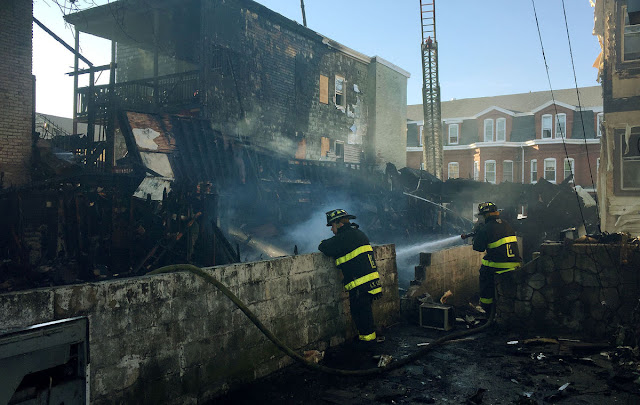
Man electrocuted by power lines on Marco Island Posted: Aug 24, 2016 4:47 PM EST Updated: Aug 24, 2016 11:25 PM EST
MARCO ISLAND, FL -
A 20-year-old man was electrocuted Wednesday afternoon on Marco Island.
Marco police confirm the man was on a ladder when it made contact with a power line. He died at the hospital. Another man was transported but is expected to survive.
It happened around 2:45 p.m. in a commercial complex just off Bald Eagle Street.
A man visiting Marco Island described the horror he witnessed trying to save the victim.
"He was just bleeding like you wouldn't believe," said Doug Gorman.
As thunderstorms rolled in, the two men were working on the roof of the building and wrapping up their job for the day when they accidentally leaned their fully extended ladder against some power lines.
"I heard a sudden, boom boom; I looked out. I could see him on the ground," Gorman said.
He raced to help the man lying in the alley behind the office building.
"He was breathing...but it was very raspy. I couldn't really feel a pulse, so I tried doing some CPR on him."
The 20-year-old man Gorman was trying to save was in bad shape.
"The blood was just... the internal amount of blood coming out of him. You could tell it was all coming out of his nose, coming out of his mouth when he would breathe. It was really bad."
EMS arrived within minutes to take the victim to the hospital, but he later died.
"I heard he was only 20 and that stunned me...that really stunned me."
People stopping in nearby businesses were also stunned by the freak accident.
"This poor guy who was just trying to do his job, just trying to get in and to happen that quick it's just scary," said Tracy Hickey.
"It makes you realize how precious life is, and that's a very young age to go," said Jill Gad.








State Issues Warning About Fish After Chemical Spill in Southington, CT
Crews are cleaning up a chemical spill (Published 5 hours ago)
Emergency crews are investigating a 400-gallon acid spill at a metals company in Southington yesterday and testing the town's water as a precaution.
A mixture of chromium acid discharged from the roof vents of the Light Metals Coloring company on Spring Street around 10 a.m. on Wednesday and crews have been working to control it, officials said.
"It was a product called hexavalent chromium and it discharged from a roof vent onto the roof of the building, and it came down through the roof drains, into the parking lot, down the roadway, and down catch basins and affected the discharge to the Quinnipwiac River," said Ken LeClerc, DEEP’s emergency response coordinator.
Officials said preliminary tests show the discharge got to the river, but information on levels has not come back.
The DEEP is urging people not to eat fish caught in the Quinnipiac River because of the chemical spill.
"We recommend that people not eat any fish taken from the Quinnipiac River between West Queen Street and downstream to Route 10 - South Main Street - in Southington until we have an opportunity to determine the extent of any lingering contamination in the river resulting from a chemical release yesterday," Deputy DEEP Commissioner Susan Whalen said.
The town shut down two wells as a precaution, but they will be reopened.
As a precaution the Southington Water Department is also testing water to ensure it is safe for drinking.
"I have worked closely with the Southington Fire Department and the Plainville-Southington Health District along with many Town, State and Federal agencies on this response. Shane Lockwood, Director of Health of the Plainville-Southington Health District, said in a statement and added that “the actions taken by the Southington Water Company, and their response partners, were timely and done in an overabundance of caution”. Lockwood also stated there are a handful of private wells in the area and those residents have been notified and sampling is being conducted on those properties.”
Officials are also testing the air.
The chemical is used in the planting industry, has a Ph of 3 and contains heavy metals.
“It's a very heavy product, it settles out quickly, but unfortunately the only way to remove it from the base of the river of the drainage is to excavate the areas affected,” LeClerc said.
Crews said they had to remove 500 cubic yards of road and it will need to be repaved.
The building department, EPA, DEEP and the Coast Guard all responded.
=================================
Town, Environmental Officials Studying Impact of Chemical Spill in Southington
The spill was at Light Metals Coloring on Spring Street in Southington.
By Chris Dehnel (Patch Staff) - August 25, 2016 2:59 pm ET

SOUTHINGTON, CT — Connecticut’s Department of Energy and Environmental Protection said Thursday that people should not eat fish taken from a stretch of the Quinnipiac River in Southington until results from water quality tests are available to assess the impact of a Wednesday chemical spill from a plant near the river in that town.
“We recommend that people not eat any fish taken from the Quinnipiac between West Queen Street and downstream to Route 10 – South Main St. – in Southington until we have an opportunity to determine the extent of any lingering contamination in the river resulting from a chemical release yesterday,” DEEP Deputy Commissioner Susan Whalen said.
The Route 10/South Main Street portion of the river is downstream from where the Eight Mile River flows into the Quinnipiac and adds a significant volume of new water to it.
Deputy Commissioner Whalen said, “Water and soil sediment samples are being taken from the Quinnipiac today and we expect to have results to look at tomorrow. This will allow us to assess the effect of the chemical release on aquatic life in those waters.”
Regulations governing fishing designate the Quinnipiac River, as it flows through Southington, as a Wild Trout Management Area, where any trout caught by anglers must be released. It is possible, however, to catch other species of fish in those waters – which anglers are allowed to take.
Late Wednesday morning a release of hexavalent chromium was reported at Light Metals Coloring, 270 Spring St., Southington, according to DEEP Officials. The release is estimated at about 300 gallons, DEEP Officials said.
The DEEP is advising the public to stay away from the banks of the Quinnipiac River in this immediate area, because of the potential for contact with hexavalent chromium in the soils there. Hexavalent chromium is linked to long term adverse health impacts – and skin irritations can be an immediate effect of contact with it.
Hexavalent chromium is a salt-like substance – associated with public health impacts – that is mixed with liquids as part of the manufacturing process at Light Metals, according to DEEP Officials.
A malfunction in the system at the plant led to liquid containing the chemical to be released through roof vents, according to the DEEP. It then drained off the roof and through roof drains, onto a road surface, a driveway, and soils – and also into a catch basin system which carried some of it out to the nearby Quinnipiac River, officials said.
DEEP emergency response personnel responded to the scene and remain there today to supervise cleanup efforts of an environmental cleanup contractor hired by the company. Road and driveway surfaces as well as soils that were potentially exposed to the hexavalent chromium are being excavated and taken away for proper disposal, a news release indicates.
The storm drain system is also being cleaned and inspected to make certain waters flowing through it do not carry more of the chemical into the Quinnipiac River, according to DEEP officials. Sampling to help determine potentially contaminated areas is also being conducted in the waters of the Quinnipiac and along its shores, according to a news release.
The Southington Water Department is working closely with the Town’s Emergency Response Team to monitor the remediation process for the chemical spill at Light Metals Coloring Company located at 270 Spring Street. As a precaution two of the SWD’s wells were temporarily shut down until there was a better understanding of the amount, type and the remediation process of the chemical spill.
"We are confident the Town of Southington’s emergency response team has the situation under control and that there will be no adverse impact to the Town of Southington’s drinking water supply," DEEP Officials said. "However, as a safeguard SWD will be conducting a series of water quality samples to ensure the water supply remains safe for consumption.
"Throughout last night, and continuing throughout this response, air, water and soil sampling have been conducted around the site of the spill. At this time, we are confident that every action has been taken to protect the public health and the environment."
=================
Cancer-causing chemical seeps in to Quinnipiac River after spill in Southington Posted: Aug 24, 2016 11:04 PM EST Updated: Aug 25, 2016 3:04 PM EST
By Evan White
By Matt Campbell
By Rob Polansky
 Crews work to clean up chemical spill at metal company in Southington (WFSB).
Crews work to clean up chemical spill at metal company in Southington (WFSB).
 DEEP officials said residents should not eat any fish that is caught between South Main Street and Queen Street (DEEP) SOUTHINGTON, CT (WFSB) -
DEEP officials said residents should not eat any fish that is caught between South Main Street and Queen Street (DEEP) SOUTHINGTON, CT (WFSB) -
Emergency crews continue to work to clean up a hazardous chemical spill at a business in Southington.
On Wednesday night, hundreds of gallons of a cancer-causing chemical called hexavalent chromium spilled out of the Light Metals Coloring Company at 270 Spring St., located near Graham Place.
The chemicals spilled onto the roof and were discharged through vents into the parking lot and road.
Crews said the spill happened after a crack formed in the water heating. Then, a boiler overflowed with gallons of the chemical.
"It ran off the roof through the drains, got into the storm system," said Chief Harold Clark, Southington Fire Department.
Crews are assessing the ground water situation in the area. Samples were taken in the Quinnipiac River basin as well as its sediment.
Light Metals said it was able to recover some of the material before it made it into the river.
However, officials confirmed that some of it spilled into the river.
People fishing in the area were told to catch and release. Local fisheries are also being monitored.
"Basically avoid the riverbank regardless," said Jeff Chandler, Department of Energy and Environmental Protection.
DEEP said it was on the scene along with Southington fire crews, the Coast Guard and the federal Environmental Protection Agency.
Jeff Chandler of DEEP said they're looking at a fourth of a mile of the river. DEEP hired Clean Harbors for the cleanup task.
There is no airborne threat, but DEEP said it's monitoring that front.
"It's a carcinogen. It is absorbable by the skin, you can inhale the dust, it can be ingested, all will cause problems," Chandler said.
Fire officials said 350 gallons of hexavalent chromium, which is widely used in various industries, spilled. They said three types of different metals are mixed in it.
DEEP said it expected to be out there all day on Thursday.
According to DEEP, workers noticed the leak Wednesday night in a boiler line that led to a chromium tank.
"It's a difficult product. There's no way to neutralize it. We've actually had to excavate the entire area of roadway. We are going to be removing approximately 5,000 square feet of the roof of the building," explained Kenneth LeClerc of DEEP.
Two drinking wells in Southington were shut down. The town water supply is not expected to be affected by the spill.
"There's no impact on the drinking water," Clark said. "It all stayed in the storm system and some of it did discharge into the Quinnipiac water basin."
Health officials, including superintendent Frederick Rogers and director Shane Lockwood, reiterated that in a statement.
We are confident the Town of Southington’s emergency response team has the situation under control and that there will be no adverse impact to the Town of Southington’s drinking water supply. However, as a safeguard [Southington Water Department] will be conducting a series of water quality samples to ensure the water supply remains safe for consumption.
Throughout last night, and continuing throughout this response, air, water and soil sampling have been conducted around the site of the spill. At this time, we are confident that every action has been taken to protect the public health and the environment.
DEEP also said there is no public health risk and that town drinking water is being tested out of an abundance of caution.
"It has some hazards to the public but not in this form," LeClerc said. "It's contained. We've been monitoring it. We've kept it secured."
Officials said not to eat fish from the Quinnipiac River in Southington because of the spill.
“We recommend that people not eat any fish taken from the Quinnipiac between Queen Street and Rt. 10 in Southington until we have an opportunity to determine the extent of any lingering contamination in the river resulting from a chemical release yesterday.” said DEEP Deputy Commissioner Susan Whalen.
Hexavalent chromium can cause skin irritation and affect organs over the long term. The chemicals can be absorbed through the skin.
Its compounds are used in paints, dyes and plastics.
According to Light Metals' website, 100 people work there.
=======================
Old Traditions
New Values
Pride. Craftsmanship. Attention to detail.
These are among the many strengths of Light Metals Coloring. For over 50 years, LMC has maintained a leadership position in finishing technology. From the earliest days, intense customer loyalty has been part of the way we do business.
The growing number of applications for aluminum, combined with LMC's reputation for customer service, have made this company one of the largest independent aluminum anodizing "job shops" in the country.
Today LMC employs over 100 people-among them some of the finest minds in the aluminum finishing trade.
New challenges face the modern finisher and we are proud of our ability to adapt and turn every challenge into an opportunity. Light Metals Coloring is committed to a conscientious manufacturing methodology. Aware of the need to protect our environment and maintain compliance with the regulatory agencies, LMC has invested significant resources in the development of "environmentally" sound processes.
You can feel good about working with Light Metals Coloring-both for the excellent work we'll do for you AND for the way we do it.


In order to stay extremely competitive, LMC has developed a specific chromating business unit, with it's own team leader that specializes in the chromating process. Each unit has it's own value stream manager who is trained to utilize LEAN techniques and to create single source responsibility to each customer. This cutting edge thinking is how you get the best quality, deliver and cost for your component.

Chromate conversion coating is a type of conversion coating applied to passivate aluminum, zinc, cadmium, copper, silver, magnesium, tin and their alloys to slow corrosion. The process uses various toxic chromium compounds which may include hexavalent chromium. The industry is developing less toxic alternatives in order to comply with substance restriction legislation such as RoHS. One alternative is trivalant chromate conversion which is not as effective but less environmentally damaging.
Chromating is commonly used on zinc-plated parts to protect the zinc from white corrosion, which is primarily a cosmetic issue. It cannot be applied directly to steel or iron, and does not enhance zinc's anodic protection of the underlying steel from brown corrosion. It is also commonly used on aluminum alloy parts in the aircraft industry where it is often called chromate conversion film. It has additional value as a primer for subsequent organic coatings, as untreated metal, especially aluminium, is difficult to paint or glue. Chromated parts retain their electrical conductivity to varying degrees, depending on coating thickness. The process may be used to add color for decorative or identification purposes.
Chromate coatings are soft and gelatinous when first applied but harden and become hydrophobic as they age. Curing can be accelerated by heating up to 70°C, but higher temperatures will gradually damage the coating over time. Some chromate conversion processes use brief degassing treatments at temperatures of up to 200°C. Coating thickness from a few nanometers to several hundred nanometers can be produced, but the Alodine and Modified Bauer-Vogel coatings on aluminium are typically a few micrometers thick.
The protective effect of chromate coatings on zinc is indicated by color, progressing from clear/blue to yellow, gold, olive drab and black. Darker coatings generally provide more corrosion resistance. Chromate conversion coatings are common on everyday items such as hardware and tools and usually have a distinctive yellow color. Steel parts must be plated with zinc or cadmium prior to chromating.
Posted 1:39 pm, August 24, 2016, by Alix Bryan, Updated at 03:36pm, August 24, 2016
RICHMOND, VA. – A fuel sheen was observed along the shoreline of the James River after a tanker overturned on Tuesday.
The fuel stretched for about a half-mile near the Richmond Deep Water Terminal, but most of the fuel is expected to evaporate today, according to the Virginia Department of Environmental Quality.
The agency is coordinating the cleanup with the Virginia Department of Transportation, the city of Richmond and the U.S. Coast Guard, as well as cleanup contractors.
The spill occurred when a tanker truck overturned while making a turn from Commerce road to Interstate 95. Fuel spilled from the tanker, which contained gasoline and diesel fuel, and some of it entered a storm drain along the road.
Fuel from the storm drain outfall then entered the James River at the deep water terminal.
The tanker was carrying about 7,500 gallons of fuel; of that, 650 gallons were recovered from the tanker and 2,700 gallons were recovered from the road.
That leaves approximately 4,150 gallons unrecovered.
Storm drains in the area were inspected Tuesday, and absorbent booms were placed in the river to contain the fuel.
Some of the fuel has accumulated along the shore. DEQ will determine how to address this while also ensuring the removal of fuel from the storm outfall.
No immediate environmental or other effects have been observed, according to the DEQ.
================
RICHMOND, Va. (WRIC) — The Virginia Department of Environmental Quality is working on a cleanup on the James River in the area of the Richmond Deep Water Terminal because of a fuel spill that occurred August 23.
The spill occurred when a tanker truck overturned while making a turn from Commerce road to Interstate 95.
Fuel spilled from the tanker, which contained gasoline and diesel fuel, and some of it entered a storm drain along the road.
Fuel from the storm drain outfall then entered the James River at the deep water terminal.
The tanker was carrying about 7,500 gallons of fuel; of that, 650 gallons were recovered from the tanker and 2,700 gallons were recovered from the road.
Storm drains in the area were inspected Tuesday, and absorbent booms were placed in the river to contain the fuel. A fuel sheen has been observed along the shoreline of the river for at least one-half mile, but most of the fuel is expected to evaporate today.
Some of the fuel has accumulated along the shore. DEQ will determine how to address this while also ensuring the removal of fuel from the storm outfall.
According to Dominion, there’s no immediate environmental or other effects have been observed. DEQ is coordinating the cleanup with the Virginia Department of Transportation, the city of Richmond and the U.S. Coast Guard, as well as cleanup contractors.
KHP responds to court ruling; out-of-state license plates don’t justify search
August 25, 2016 by Hays Post
TOPEKA, KS – The Kansas Highway Patrol has responded to the 10th Circuit Court of Appeals ruling on Tuesday that says law enforcement officials in Kansas cannot stop and search motorists for having nothing more than out-of-state license plates from states that have legalized marijuana.
The court said the officer’s reasoning would justify the search of citizens from more than half of the states in the country.
The court reinstated the lawsuit filed by a Colorado motorist against two Kansas Highway Patrol officers who stopped and searched his vehicle while he was driving alone at night on I-70 in Kansas.
It found the officers violated Peter Vasquez’s Fourth Amendment rights in searching his car.
Twenty-five states permit marijuana use for medicinal purposes, with Colorado, Alaska, Oregon, Washington, and Washington, D.C. permitting some recreational use under state law.

Unfortunately these patrol cops do it all the time, i.e., violate people's civil rights against unreasonable searches. We are aware of numerous cases where people driving at night are stopped on a routine basis throughout the US and not just Kansas. The cops find these days a very typical excuse, such as : "swerving to the right or left".
Using this "swerving" pretext, they stop, detain and search the vehicles. They have caused enormous damages to so many citizens and they always get away with it. Hopefully this above Court Decision will be the beginning of the end for just illegal stops and searches and detainment.
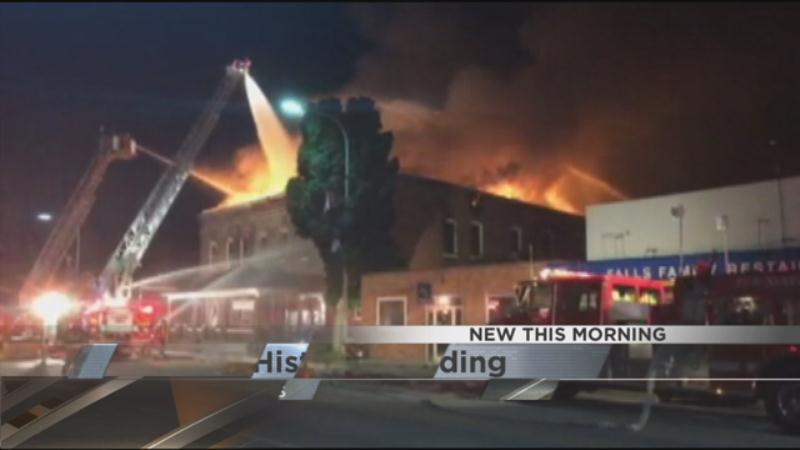
Posted: Aug 25, 2016 6:56 AM EST Updated: Aug 25, 2016 7:12 AM EST
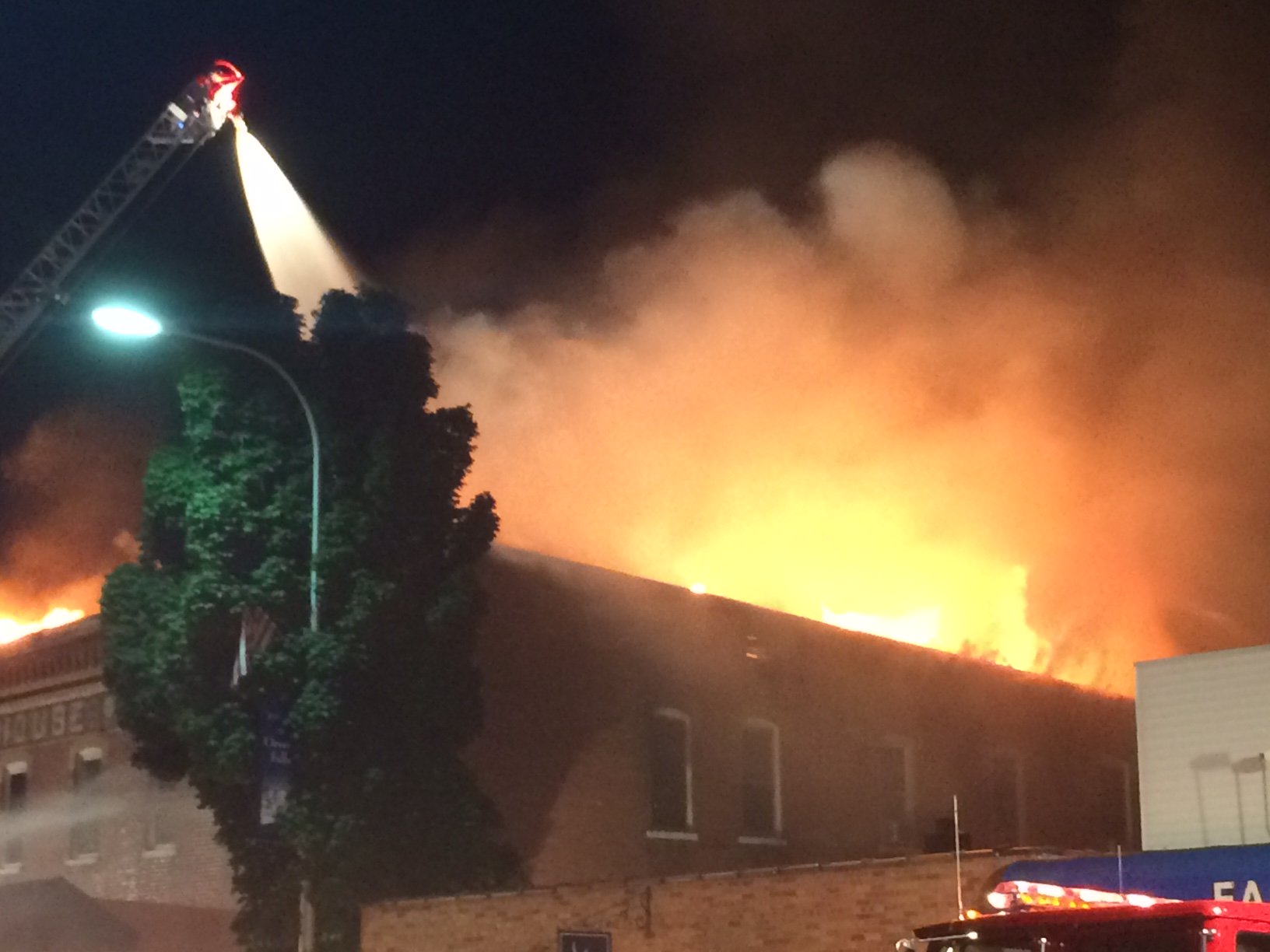 Courtesy: WBAY/Twitter
Courtesy: WBAY/Twitter
OCONTO FALLS, WI (WKOW) -- A massive fire broke out at the Caldwell House, a 121-year-old building in downtown Oconto Falls, WI late Wednesday night.
WBAY-TV reports firefighters were called to the Caldwell House on Main Street August 24. They battled large flames overnight and finally got the fire under control early Thursday morning.
Firefighters tell WBAY the fire started in the attic and spread quickly while crews evacuated people from the second floor apartments. No one was injured. "By the time we got halfway through the building, the fire started coming down on us already, so we had to quit. Good thing was that everyone did get out of the building, as far as we know everyone got out,” Chief Tim Magnin with Oconto Falls Fire Department told WBAY.
Chief Magnin says several families have been displaced. The American Red Cross is helping them.
The fire department says there is smoke and fire damage throughout the historic building. The age of the building presented some challenges for crews. There are no "fire stops" in the walls, and that allows flames to spread more quickly, firefighters tell WBAY.
The Wisconsin Historical Society says Caldwell House was built in 1895 as a hotel. More recently, it was a pub and restaurant. It was being remodeled into a night club.
“It’s one of the landmarks, what they called the Saunders building, way back in the day. Built in 1895,” Chief Magnin told WBAY. “So it’s kind of a landmark in the city, it’s kind of a loss to the city, but thank God nobody got hurt.”
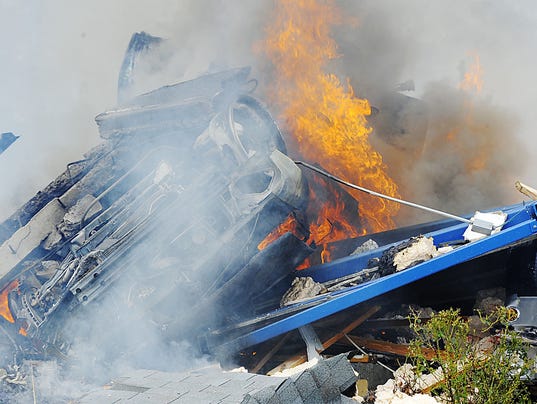
(Photo: Photo: Kevin G. Gilbert/Herald-Mail Media, www.heraldmailmedia.com)
Explosion sparks massive fire in Maryland
Dustin B Levy, dlevy@eveningsun.com 7:30 p.m. EDT August 25, 2016
Nearly 70 firefighters from Pennsylvania, Maryland and West Virginia are responding to the scene of an active fire and explosion in Washington County, Maryland, according to a news release from the Maryland State Fire Marshal.
The two-alarm fire was reported at a home at 14205 Hollow Road in Hancock, Maryland at 8:51 a.m., according to the news release.
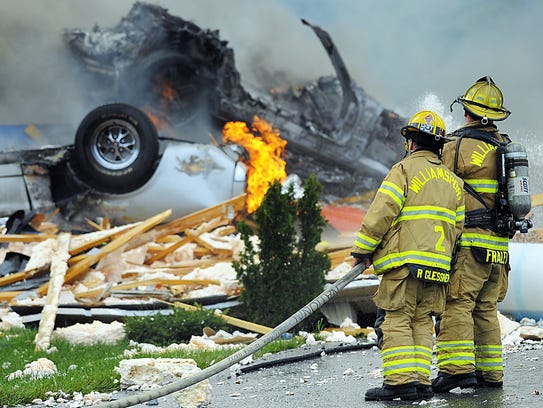
Firefighters work to put out fires following an explosion at a residence in Hancock, Maryland, Thursday. (Photo: Photo: Kevin G. Gilbert/Herald-Mail Media, www.heraldmailmedia.com)
Hancock is about 80 miles southwest of Hanover and 50 miles southwest of Chambersburg.
McConnellsburg Fire Company from Fulton County responded, but there were no companies sent from Franklin County, according to the dispatch center.
Ben Hoopengardner, deputy chief of the Hancock Volunteer Fire Company, told Herald-Mail Media of Hagerstown, Maryland, "it was obvious some type of explosion occurred to the front of the house. There were some cars piled up in the front yard, as well as some of the house laying out in the yard."
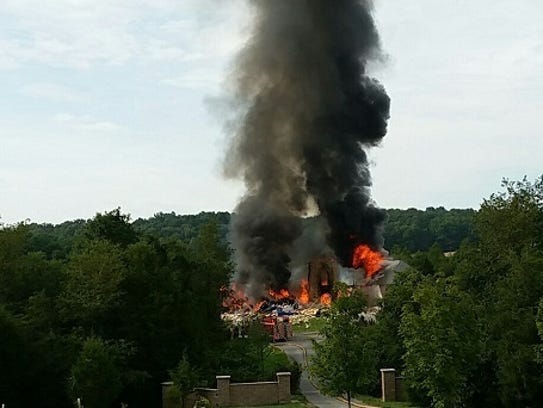
Reported fire in Hancock, Maryland on August 25, 2016 (Photo: Submitted)
A female occupant of the 10,000-square foot, two-story home escaped the blaze without injury, according to the news release. An off-duty Maryland State Trooper who lives nearby responded initially, assisting her away from the home.
The Office of the Maryland State Fire Marshal has a team of investigators currently on the scene, according to the news release.
Jul 29, 2016
PHMSA 18-16
Friday, July 29, 2016
Contact: Artealia Gilliard
Tel: 202-366-4831
PHMSA Proposes $1.6M in Civil Penalties to the Transcontinental Pipeline Company (Transco)for Safety Violations Following Fatal 2015 Louisiana Compressor Station Explosion that Killed Four Workers
WASHINGTON – The U.S. Department of Transportation's Pipeline and Hazardous Materials Safety Administration (PHMSA) today proposed $1.6 million in civil penalties and issued a Notice of Probable Violation (NOPV) and a Proposed Compliance Order to the Transcontinental Pipeline Company (Transco) for violations of the Federal pipeline safety regulations.
The actions are related to an October 8, 2015 incident resulting in the deaths of four workers due to a series of explosions and a fire. Nearby residences were also evacuated and a state highway was closed. The Transcontinental Gas Pipe Line Company, LLC is a subsidiary of Williams Partners L.P., which owns and operates more than 33,000 miles of pipelines nationwide.
PHMSA’s investigation into the cause of the October incident near Bayou Black, Louisiana, uncovered five alleged instances of noncompliance with Federal pipeline safety regulations. The instances of noncompliance include failing to report all significant facts when reporting the incident to the National Response Center and performing welding on pipeline components that contain a combustible mixture of gas and air. The Proposed Compliance Order incorporates remedial actions that correspond to each alleged violation to ensure compliance with pipeline safety regulations and improve safety.
The Transco Compressor Station 62 facility is located between Gibson and Houma, LA near Bayou Black, where it receives unprocessed natural gas via pipelines from offshore producers in the Gulf of Mexico.
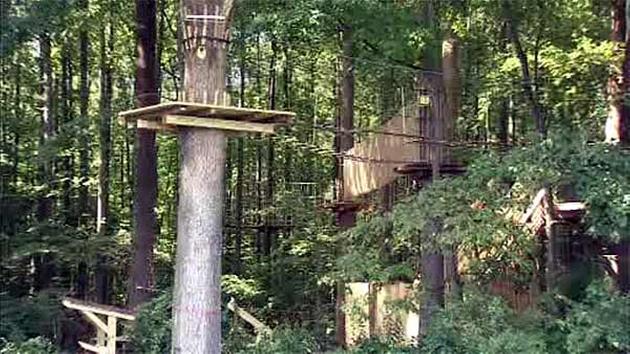
A 59-year-old woman is dead after falling approximately 40 feet from a zip line at a Delaware state park, police say.
By RANDALL CHASE
Updated 38 mins ago
BEAR, Del. -- A woman who fell 35 feet to her death from a zip line platform had disconnected herself from the safety system, the attraction's operator said Thursday.
Delaware State Police investigators are investigating how Tina Werner tumbled off the platform at the Go Ape Tree Top Adventure attraction in Lums Pond State Park on Wednesday.
Participants at Go Ape courses are equipped with climbing harnesses and two sets of ropes with carabiners that they unclip and clip to safety wires in sequence as they move through the trees.
PHOTOS: Woman dies after falling 40 feet in zip line accident:

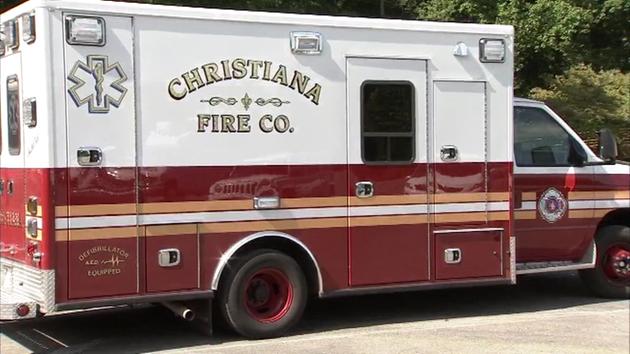

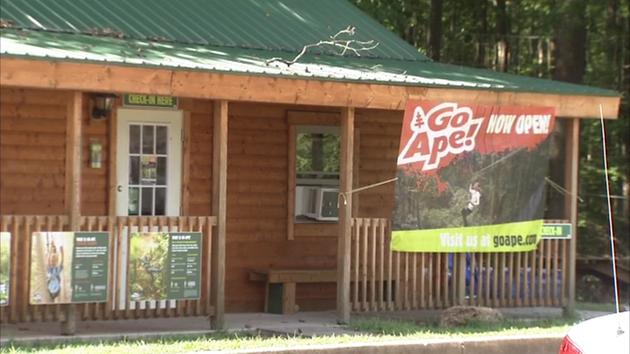
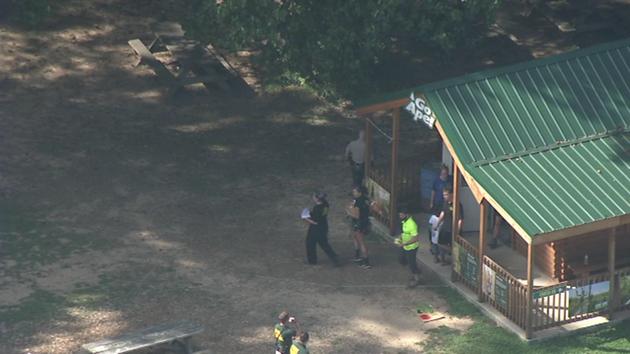


A 59-year-old woman is dead after falling approximately 40 feet from a zip line at a Delaware state park, police say.
Werner, 59, of Felton, had completed the required safety training, and was nearing the end of the course when she fell, said Jeff Davis, a spokesman for Go Ape. The attraction in Bear spans seven acres and includes four zip lines and a variety of swings, rope ladders, bridges and trapezes.
"Participant witnesses have stated that at the time of the accident the participant had unfortunately disconnected herself from the safety system," Davis said in an email.
An inspection found that all of the course and associated safety equipment was in sound operating condition, and that "nothing was broken or unserviceable," Davis wrote.
Werner's daughter, Melissa Slater, described her mom as "super fun," and "adventurous." After traveling to Venice, Italy and taking a hot-air balloon ride, Werner had told her daughter Tuesday that riding the zip line was next.
"She was finishing her bucket list," said Werner's daughter, Melissa Slater.
According to the website of Go Ape, which is based in Frederick, Maryland, and operates attractions in 15 states, patrons receive a 30-minute training session before being turned loose on the course, which can take them as high as 50 feet in the air.
While participants navigate the course without direct supervision, Go Ape says its instructors are constantly patrolling the course to offer assistance and encouragement as needed.
"Waivers are signed by participants to accept responsibility for following the safety rules and advice on the course and assume all risks associated with his/her participation," the company's website states. "These safety rules are communicated thoroughly in a safety brief that is required of every participant before they Go Ape."
Slater said her mom, who was visiting Lums Pond with a friend, was able to complete at least one zip line ride before falling.
"So she did do it," said Slater, who posted a tribute on Facebook.
The Go Ape attraction opened at Lums Pond in 2013, and Davis said its equipment is regularly inspected. He said the attraction has been closed for now to help with the investigation, and out of respect to Werner's family.
"The Go Ape company is extremely saddened by this," he said.
Park rangers and Go Ape employees performed first aid on Werner until paramedics arrived, but she was pronounced dead at Christiana Hospital. An autopsy was planned.
4-alarm fire started in building occupied by homeless, mayor says
Lawrence firefighters battle blaze on Summer Street
UPDATED 12:19 PM EDT Aug 25, 2016
LAWRENCE, Mass. —A fire destroyed two buildings and damaged four other apartment buildings early Thursday in Lawrence.
Lawrence Mayor Dan Rivera said 29 Summer Street was occupied by homeless people just before the flames lit up the sky early Wednesday morning.
"Because of the homelessness issue, we had somebody using an inappropriate space, and that's where the fire started,” he said.
Investigators are working to determine the cause of the four-alarm fire. The heat was so intense that the siding of a nearby home melted off. The flames jumped to other houses in the neighborhood.
"The actual fire building is a complete loss, and the exposure on the, what we call the delta side, the right-hand side of the house, is only a 4-inch alleyway. We had multiple triple-deckers in the back, before you even get to the next street,” Lawrence Fire Department Chief Brian Moriarty said.
Residents of surrounding buildings were evacuated.
Rivera called the abandoned house a "problem property" that the city had been fighting to have torn down.
"We're trying to figure out our homeless issue here, so trying to get places for people to go, and when you don't have that, people are going to figure out a way to squirrel away,” he said.











































